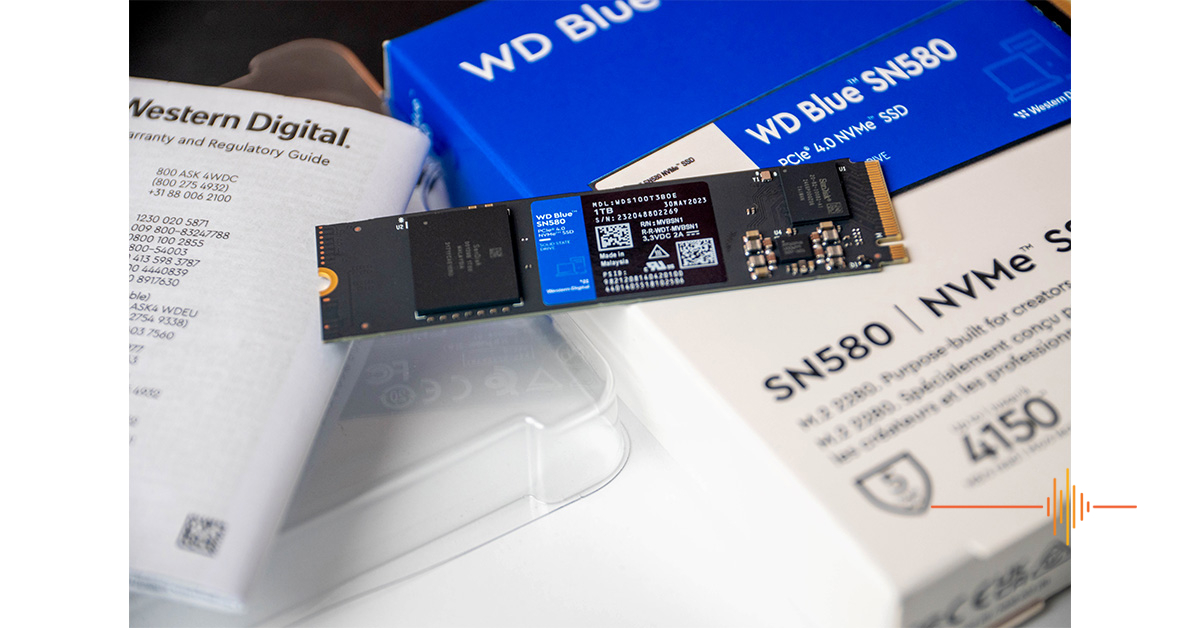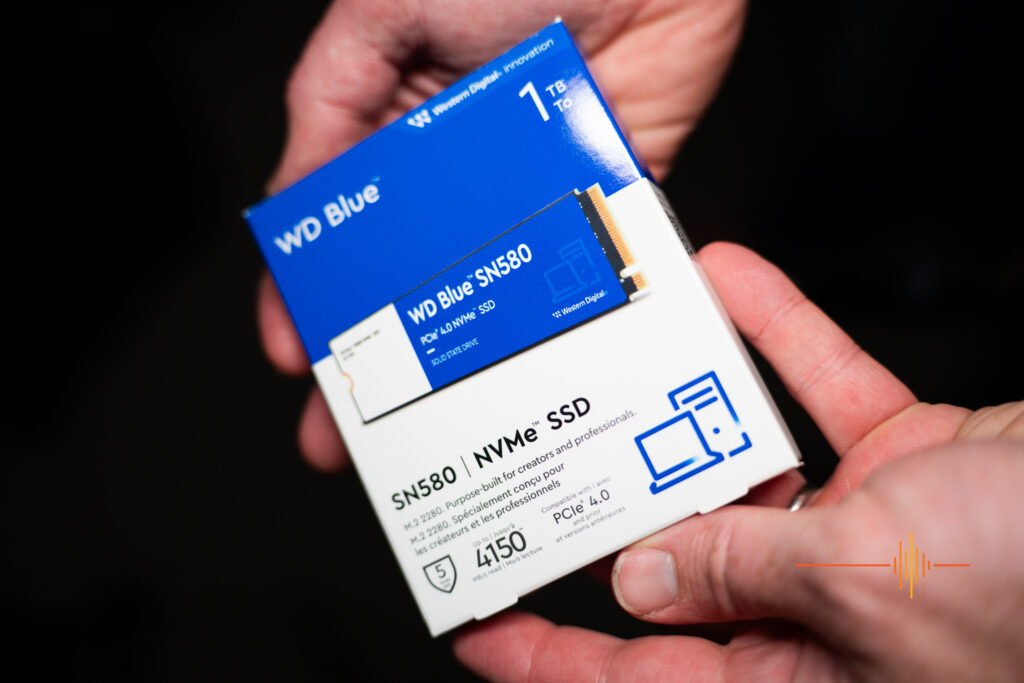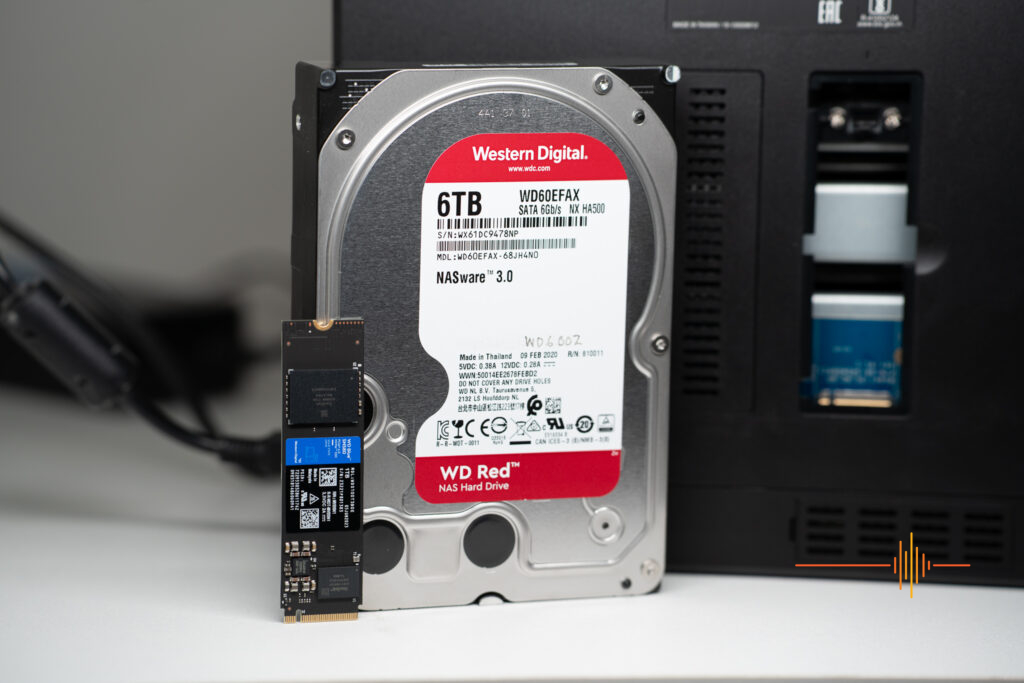I’ve was recently sent a tiny little 1TB WD Blue SN580 NVMe M.2 SSD to review. While I wasn’t in a position to open up my computer (an iMac) and use the SN580 for that (I didn’t have all the tools and suction cups and frankly the guts!), However, I did have a Synology NAS (Network Attached Storage, most people see them and call them servers rightly or wrongly) that would accommodate the WD Blue SN580 NVMe M.2 SSD and use it as a tidy little cache drive, and so that’s the task it was assigned.
A ‘what’? Sure thing! Think of an M.2 NVMe SSD like a super-fast, ultra-efficient digital storage chip that’s small and can easily plug into a slot on your computer’s motherboard or, in this case your NAS (if it has the right slot of course). It’s like a really quick and reliable place where your computer keeps important stuff like files, programs, and data, typically stuff that it needs to grab often.
Now, what makes it stand out? Well, it’s like having a tidy Porsche among cars. The M.2 NVMe SSD works at lightning speed compared to the older, slower hard drives. It does this by using a special technology (NVMe) that lets it talk to your computer’s brain (the CPU) really, really fast. This means everything you do on your computer – from starting it up to loading games or files – happens much quicker. And one of the added benefits? It’s super tiny, so it doesn’t take up much space inside your chosen host, and it doesn’t need all those messy cables. Just plug it in, and your computer typically gets a huge speed boost!
So the tiny (and they are very small! see the photo below) 1TB WD Blue SN580 NVMe M.2 SSD is much faster than the 5400rpm HDD I hear you ask… Yes, much faster – the one I have here on test is rated at UP TO 4150 MB per second read speeds, where amore traditional 5400rpm spinning HDD can maybe pull 150 to 180MB per second – so significantly slower, that said, the WD HDD I’m using in this test are made for the NAS environment, and so a slower disk can mean less heat, and less heat always means a longer life in a computer or server that’s always on.
In my use-case, A cache drive in my NAS will act as kind of like a buffer for your regular, typically not super-fast NAS drives, the ones in this Synology DS920 are also WD, 4Tb (Not shown, that’s a 6Tb from something else, just for size comparison – well spotted, you eagle-eye!) spinning drives that have a top speed of 5400rpm. While the HDD do have a small cache (usually around 64mb) that’s not a lot to fill up if you’re loading a larger file or files into the drive, so – very very basically! – the cache will sit between your requested files and your NAS’ hard drives and take the file into its memory much much quicker than if you were to send the files directly to the NAS HDDs spinning at 5400rpm. All of that said, a NAS drive doesn’t need to be super quick, typically you’ll find a bottleneck of speed well before things get to the drives, poor network setup is where it happens for me, but the M.2 NVMe can also help in other ways on your NAS.
An M.2 cache drive in a NAS (Network Attached Storage) works as a high-speed storage buffer that enhances the overall performance of the NAS system. Here’s what it does:
- Speeds Up Data Access: The M.2 cache drive stores frequently accessed data temporarily. When data is needed, the NAS checks this cache first. If the required data is present in the cache, it can be retrieved much faster than fetching it from the main, slower storage drives (usually HDDs or SATA SSDs).
- Improves Read and Write Performance: By caching frequently used data, the M.2 drive accelerates access to commonly accessed files, applications, or chunks of data. This speeds up both read and write operations, enhancing the overall responsiveness of the NAS system.
- Efficiently Manages Data: The cache drive uses intelligent algorithms to identify data patterns and stores frequently accessed data for quick retrieval. As data usage patterns change, the cache adapts to accommodate new data or different access patterns, optimizing its effectiveness.
- Reduces Load on Main Storage: Storing frequently accessed data in the cache reduces the workload on the main storage drives. This can prevent bottlenecks during periods of high demand and prolong the lifespan of the main storage drives by minimizing their continuous use.
- Optimises Network Traffic: The cache reduces the need to fetch data from slower external sources (like the internet or other networked devices) if the required data is already cached within the NAS system. This optimization can significantly enhance network performance.
In essence, the M.2 cache drive acts as a rapid-access buffer, aiming to boost data access speeds and system performance by storing frequently used data for quick retrieval, ultimately improving the overall efficiency of the NAS system.
The benefits of faster cache drives like this WD Blue SN580 NVMe M.2 SSD in a NAS are not as immediately noticeable as those if installed in a computer, but they are certainly there are. For the relatively inexpensive cost and absolute ease of fitting one in your NAS, you’d kinda be crazy not to (if your NAS can fit on!). It has a RRP of around AUD$113 but at time of publish you still can get a Black Friday deal on it for AUD$80.27.
DRN would like to thank WD for providing the review unit.





